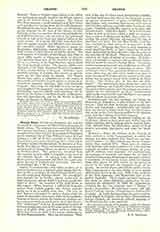

Orange River, Vicariate Apostolic of, and the PREFECTURE APOSTOLIC OF GREAT NAMAQUALAND, in South Africa. The vicariate was erected in 1897 after having been a prefecture Apostolic since July, 1885. It comprises the whole of Little Namaqualand (beginning on the northern line of Clan William County in Cape Colony, i.e. 30° 35′ S. lat.); extends to the Atlantic Ocean on the west, and to the Orange River on the north. It further includes Bushmanland, the districts of Kenhardt, Van Rhyns, Dorp, and Frazerburg on the east, and beyond the Orange River, the district of Gordonia in Bechuanaland. The prefecture, detached from the vicariate in July, 1909, is bounded on the west by the Atlantic Ocean. It extends from the Orange River as far as Damaraland (23° 20′ S. lat.), and comprises the city of Rehboth and its district. The eastern boundary line is 20° E. long.
GREAT NAMAQUALAND.—For thirty or forty, or in certain districts even a hundred miles inland, this district is only a sandy desert, which extends on the eastern side to the great Kalahari desert. The central portion depends for its fertility almost exclusively on thunderstorms, without which it would be nearly destitute of water. The vicariate is but little better in this respect. When, however, a sufficiently long rain waters these forlorn regions, the richest pastures spring up in an incredibly short time. The very air then becomes saturated to such a degree with the odor of vegetation that many suffer from headache. Swarms of locusts devour the exuberant produce, unless some powerful east wind carries them into the sea. The “aristocracy” in Great Namaqualand consists of German immigrants, and, in the other parts of the mission, of English, Irish, and Boer settlers, while the Hottentots form the bulk of the scanty population in the two Namaqualands. They are not negroes. Their skin is like that of whites much browned by jaundice, and their build more like that of the Egyptians as seen on ancient monuments; or again, resembling that of the Chinese, only exceeding them or any other race on earth in their ugliness, especially when burdened with years. Unselfish hospitality appears to be their only natural virtue. They love music. Their habit of imitating is such as to rouse either a smile or exasperation; a crowd of Hottentots at Holy Mass, when receiving the priest’s blessing, all repeated the sign of the Cross over him! The late Max Milner, nevertheless, vouched for their ancestors having been a cultured race. Although they have in their language a word signifying Deity, it took a long time to make them understand spiritual doctrines other than that of the existence of the devil. They are extremely disinclined to any form of labor or exertion. To induce them, for example, to navigate, the missionaries built a boat by which to cross the Orange River. For weeks, neither encouraging words nor exhibitions of safe sailing appeared to make any impression on them. One missionary relates that, among his Hottentot catechumens, there was one who never could learn how to make the sign of the Cross, nor the answers of the catechism, nor any prayer except these words of the Pater Noster: “Our Father, give us this day our daily bread.” The missionaries have shown here what an uplifting influence the Catholic Church exercises over the most forlorn nations, since the younger generation, trained by the missionaries as far as circumstances allowed, are considerably more intelligent and susceptible of culture than their elders.
BUSHMANLAND.—In this territory are found the Bushmen (or Bojesmen), a tribe kindred to the Hottentots. They are short in stature, and generally malicious and intractable. Intellectually and morally they are not on a higher level than the Hottentots, but, as far as they have been accessible to the missionaries, they have improved in both respects.
BECHUANALAND.—The Bechuanas belong to the Kafir race. Many of them show some skill in iron and copper working and in mining, also in tanning hides. Very different from the Hottentots, many of them present a pleasing appearance, and some are handsome.
MISSIONS.—When the Oblates of St. Francis de Sales arrived in Little Namaqualand, to which the mission was then confined, they found not one hundred Catholics. In 1903, without any change of population, they counted 2735. There were six stations with churches and resident priests, five other stations regularly attended, 125 conversions during the year, and 98 children were baptized; 122 confirmations, 25 marriages; 3 hospitals and homes for the aged, 8 schools, 3 orphanages, 82 orphans, 8 missionary priests, 3 catechists; 15 missionary sisters aided the mission. Some fifty places are now visited by the priests to attend to the spiritual and temporal wants of the people. In several places, all Catholic adults receive Holy Communion on the first Friday of every month and the great feasts of the year. Sella is the residence of the vicar Apostolic, and Hierachalis that of the prefect Apostolic. These results are most encouraging, when the great difficulties confronting the missionaries are considered. In 1909 the approximate statistics for the two missions were: 1 bishop; 14 priests; 3 catechists; 22 missionary sisters; 480 children in Catholic schools; 175 baptisms of children, 315 of adults. In Little Namaqualand the natives understand Dutch or English; but in Great Namaqualand, besides German, the extremely difficult language of the Hottentots has to be mastered.
J. J. ISENRING

